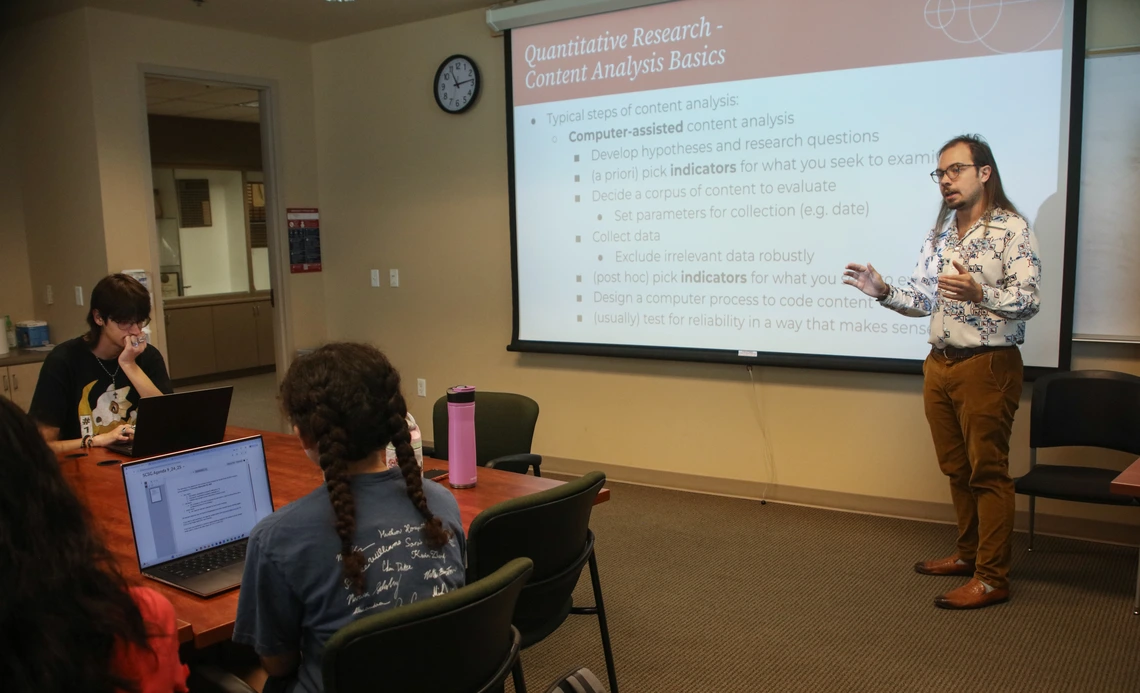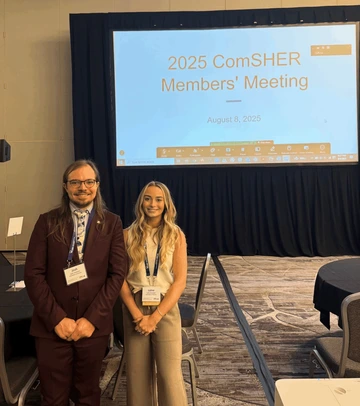New VIP Team Studies How Science Communication Can Drive Social Good

Dr. Josh Anderson leads a meeting of the Science Communication for Social Good VIP team.
A new research team of faculty and students at the University of Arizona is working to understand how science communication can better reach people in ways that effect positive change.
The Science Communication for Social Good team, along with its related course, was developed as part of the university’s Vertically Integrated Projects (VIP) program, which allows students to collaborate with faculty on long-term, multidisciplinary projects.
Dr. Josh Anderson, an assistant professor in the School of Journalism and director of Science Communication for Social Good, said he was inspired to form a VIP team as a way to provide students with hands-on research experience while examining how science is shared with the public.
“I think there’s value in understanding science journalism and other forms of science communication from an evidentiary, research-based perspective so that we are able to see, in rigorous detail, how science communication works as a social institution,” Anderson said.
The team is co-directed by Dr. Yotam Shmargad, an associate professor in the School of Government and Public Policy, and welcomes both undergraduate and graduate students of any major, who can earn academic credit for their work.
Weekly meetings allow students to discuss research topics with experienced faculty and learn social science research methods, from conducting surveys and interviews to collecting and analyzing qualitative data. Students can then apply that training as they collaborate on research projects related to science communication, which can encompass a wide range of topics such as climate change, bioethics and the societal impacts of AI and emerging technologies.
While all new team members contribute to the group’s main projects, those who return for multiple semesters are encouraged to develop their own studies and take on mentoring roles.
Student Involvement
Laine Kowalski, a graduate student in the School of Journalism and Science Communication for Social Good team member, first found her passion for science in high school after taking astronomy and physics classes.
“Even though it was very difficult, it was something I was really fascinated with, so I stuck with it,” Kowalski, who graduated from the university this year with a B.S. in Astronomy and a B.A. in Journalism, said.
When she worked as a summer intern for Northrop Grumman her freshman year, she was tasked with writing a newsletter about the first ever images captured by the James Webb Space Telescope and released by NASA. This experience, combined with her work as a student writer for the Office of Research and Partnerships (ORP), inspired her to learn how scientists can more effectively communicate their work with a wide audience.
“We’re looking at how science communication affects society, how people perceive science and how they disseminate science information—making it accessible, making it so that people can understand it and are interested in it,” Kowalski said.

Dr. Josh Anderson and graduate student Laine Kowalski attend the 2025 Association for Education in Journalism and Mass Communication (AEJMC) conference.
Prior to joining the VIP course, Kowalski worked with Professor Anderson on a political communications research study that they presented at the 2025 Association for Education in Journalism and Mass Communication (AEJMC) conference in San Francisco, California. She now plans to apply the skills she learned as an undergraduate to explore the intersection of politics and science communication.
“I’m fascinated with how leaders are trying to communicate science and how people are perceiving it,” Kowalski said. “If people at the top don’t understand all of the nuances of how science works, they may miscommunicate that and then you get misinformation and overexaggerations.”
Harshit Khatwani, an undergraduate journalism and global studies student, joined the Science Communication for Social Good team with similar interests.
“I think science and politics often go hand-in-hand because how people perceive science research depends on their political biases a lot of the time, which made me curious to learn more,” Khatwani said.
With a background in political science research, Khatwani sees the VIP course as a way to examine complex social issues like climate change from a more data-driven perspective.
The Science Communication for Social Good team is currently full for the fall, but students interested in investigating science and society can apply in future semesters and learn more about the team online.

